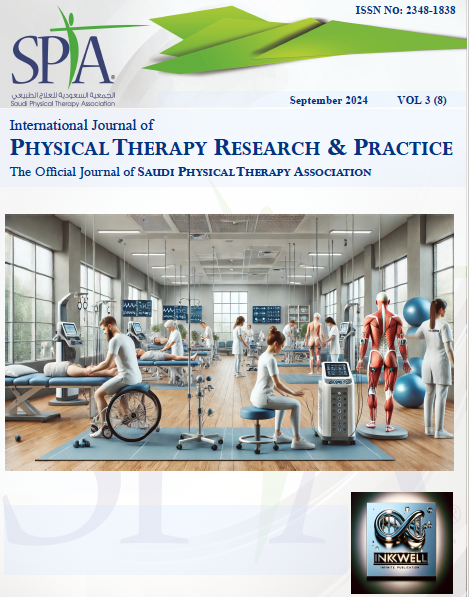Assessing the knowledge, Awareness, and potential impact of physiotherapy in fracture rehabilitation among Al-Baha Population: A comprehensive analysis
DOI:
https://doi.org/10.62464/ijoprp.v3i8.49Keywords:
Physiotherapy, fractures, knowledge, Awareness, physical therapy, bone fracturesAbstract
Background: Fractures represent one of the most significant public health concerns globally, impacting different individuals. Understanding the public perspectives on managing fractures, including physical therapy (PT), is essential. Therefore, this study aimed to assess the knowledge, Awareness, and potential impact of physiotherapy in fracture rehabilitation among the Al-Baha Population. Methodology: This cross-sectional Study was conducted in the Al-Baha region of Saudi Arabia. It relied on a structured Arabic online questionnaire designed by the authors, considering the characteristics of the study population. A pilot study was conducted to refine the questionnaire before distributing it. A convenience sample of 429 participants (243 males and 186 females) with a mean age of 34.06 ± 12.43 years responded to the questionnaire. Data regarding demographic information, previous fracture experience, knowledge, and attitudes toward physical therapy were collected. The Chi-Square test was used to assess significant associations between variables. Results: Among the participants, 32.6% reported a history of fractures, with splinting being the most common treatment modality (30.5%). It was found that 65.3% strongly agree that physical therapy plays a pivotal role in fracture healing. Participants emphasized the significance of early PT (73.4% very Important) and patient education regarding physiotherapy (71.6% very important) post-fracture. Support for resource allocation towards PT research (64.6% strongly agree) and integration into fracture treatment plans (50.3% strongly agree) was also substantial. Educational attainment significantly influenced knowledge levels about physical therapy. Conclusion: This Study underscores the community's recognition of physical therapy as integral to fracture management, advocating for its early implementation and robust support in healthcare policies. Enhanced educational initiatives and equitable access to rehabilitative services are essential to optimize fracture recovery outcomes and reduce long-term sequelae.
References
Albishi, A. M. (2024). Knowledge, attitudes, and perceptions of physical therapists towards conventional physical therapy: A cross-sectional study. Annals of Medicine and Surgery, 86(4), 1942-1949. https://doi.org/10.1097/MS9.0000000000001883
Alhumaid, M. M., & Said, M. A. (2023). Increased physical activity, higher educational attainment, and the use of mobility aids are associated with self-esteem in people with physical disabilities. Frontiers in Psychology, 14. https://doi.org/10.3389/fpsyg.2023.1072709
Alshammari, T. K., Alonazi, A. A., Alsweed, A. I., & Alasous, R. A. (2023). Identifying factors prevent patients’ accessibility to musculoskeletal physical therapy in Saudi Arabia: A retrospective cohort analysis. Australian Journal of Basic and Applied Sciences, 17(11), 7-12. https://doi.org/10.22587/ajbas.2023.17.11.2
Atkinson, K., Coutts, F. J., & Hassenkamp, A.-M. (2005). Physiotherapy in orthopedics: A problem-solving approach. Elsevier Health Sciences. https://books.google.com.eg/books/about/Physiotherapy_in_Orthopaedics.html?id=KOh20Vl3vrAC&redir_esc=y
Barake, M., El Eid, R., Ajjour, S., et al. (2021). Osteoporotic hip and vertebral fractures in the Arab region: A systematic review. Osteoporosis International, 32(8), 1499-1515. https://doi.org/10.1007/s00198-021-05937-z
Bubshait, D., & Sadat-Ali, M. (2007). Economic implications of osteoporosis-related femoral fractures in Saudi Arabian society. Calcified Tissue International, 81(6), 455-458. https://doi.org/10.1007/s00223-007-9090-5
Doshi, D., Jiandani, M., Gadgil, R., & Shetty, N. (2017). Physiotherapy awareness in medical and non-medical population: A social media survey. International Journal of Physiotherapy Research, 5(2), 1971-1975. https://doi.org/10.16965/ijpr.2017.119
Jasiak-Tyrkalska, B., & Czerwiński, E. (2006). Physiotherapeutical management after osteoporotic fractures. Ortopedia, Traumatologia, Rehabilitacja, 8(4), 388-394. http://www.ncbi.nlm.nih.gov/pubmed/17597682
Kim, T., See, C. W., Li, X., & Zhu, D. (2020). Orthopedic implants and devices for bone fractures and defects: Past, present and perspective. Engineering Regeneration, 1, 6-18. https://doi.org/10.1016/j.engreg.2020.05.003
Krischak, G. D., Krasteva, A., Schneider, F., Gulkin, D., Gebhard, F., & Kramer, M. (2009). After volar plating of wrist fractures, physiotherapy is effective using a home exercise program. Archives of Physical Medicine and Rehabilitation, 90(4), 537-544. https://doi.org/10.1016/j.apmr.2008.09.575
Liang, W., Zhou, C., Bai, J., et al. (2024). Current advancements in therapeutic approaches in orthopedic surgery: A review of recent trends. Frontiers in Bioengineering and Biotechnology, 12. https://doi.org/10.3389/fbioe.2024.1328997
Meeks, S. M. (2005). The role of the physical therapist in the recognition, assessment, and exercise intervention in persons with, or at risk for, osteoporosis. Topics in Geriatric Rehabilitation, 21(1), 42-56. https://doi.org/10.1097/00013614-200501000-00006
Montero-Odasso, M., van der Velde, N., Martin, F. C., et al. (2022). World guidelines for falls prevention and management for older adults: A global initiative. Age and Ageing, 51(9). https://doi.org/10.1093/ageing/afac205
O’Brien, L. (2012). The evidence on ways to improve patient’s adherence in hand therapy. Journal of Hand Therapy, 25(3), 247-250. https://doi.org/10.1016/j.jht.2012.03.006
Sadat-Ali, M., Al-Dakheel, D. A., Azam, M. Q., et al. (2015). Reassessment of osteoporosis-related femoral fractures and economic burden in Saudi Arabia. Archives of Osteoporosis, 10(1), 37. https://doi.org/10.1007/s11657-015-0240-5
Sadat-Ali, M., Al-Habdan, I. M., Al-Turki, H. A., & Azam, M. Q. (2012). An epidemiological analysis of the incidence of osteoporosis and osteoporosis-related fractures among the Saudi Arabian population. Annals of Saudi Medicine, 32(6), 637-641. https://doi.org/10.5144/0256-4947.2012.637
Saleh, Y. A. L., Sulimani, R. A., Alomary, S., et al. (2022). Incidence of hip fracture in Saudi Arabia and the development of a FRAX model. Archives of Osteoporosis, 17(1), 56. https://doi.org/10.1007/s11657-022-01085-x
Saudi Building Code National Committee. (n.d.). General information. Saudi Building Code National Committee. https://bcci.org.sa/?page_id=1347
Schlickewei, C. W., Kleinertz, H., Thiesen, D. M., et al. (2019). Current and future concepts for the treatment of impaired fracture healing. International Journal of Molecular Sciences, 20(22), 5805. https://doi.org/10.3390/ijms20225805
Singam, A. (2024). Mobilizing progress: A comprehensive review of the efficacy of early mobilization therapy in the intensive care unit. Cureus. https://doi.org/10.7759/cureus.57595
Tasheva, R. (2020). Physiotherapy after surgically stabilized proximal tibia fracture. Trakia Journal of Sciences, 18(2),156-160. https://doi.org/10.15547/tjs.2020.02.011

Downloads
Published
Issue
Section
License
Copyright (c) 2024 International Journal of Physical Therapy Research & Practice

This work is licensed under a Creative Commons Attribution-NonCommercial-NoDerivatives 4.0 International License.




